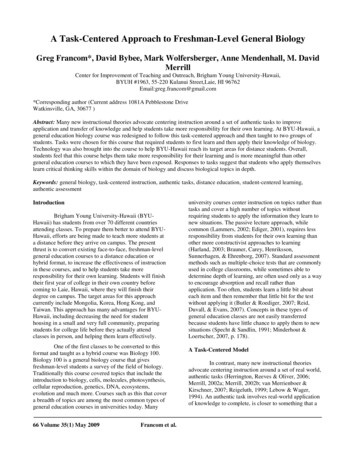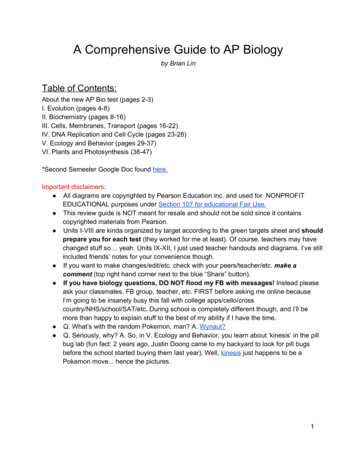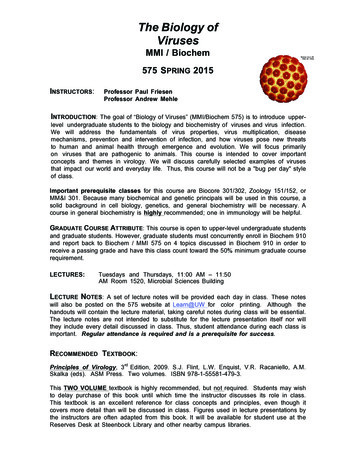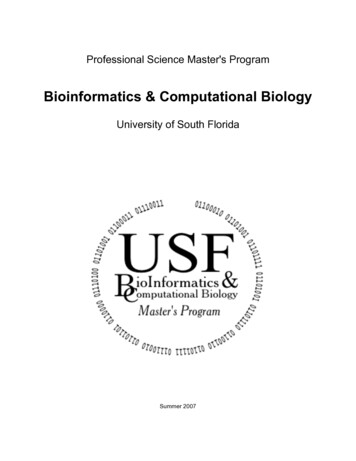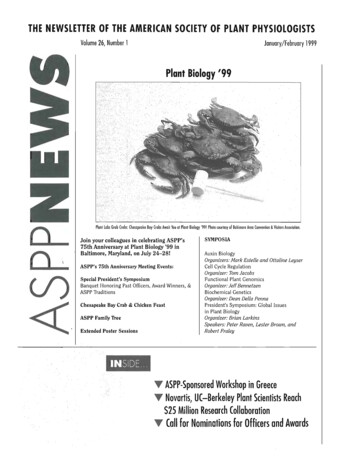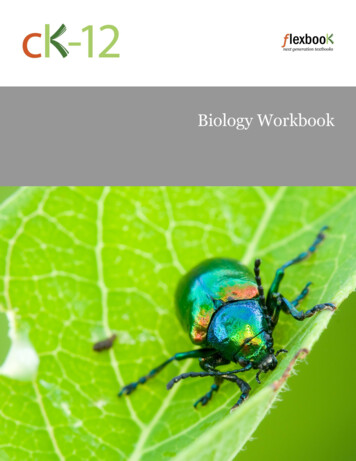
Transcription
Biology WorkbookDouglas Wilkin, Ph.D. (DougJW)Douglas Wilkin, Ph.D. (DWilkin)Margaret Lynch, Ph.D. (MLynch)Say Thanks to the AuthorsClick http://www.ck12.org/saythanks(No sign in required)
www.ck12.orgTo access a customizable version of this book, as well as otherinteractive content, visit www.ck12.orgCK-12 Foundation is a non-profit organization with a mission toreduce the cost of textbook materials for the K-12 market bothin the U.S. and worldwide. Using an open-content, web-basedcollaborative model termed the FlexBook , CK-12 intends topioneer the generation and distribution of high-quality educationalcontent that will serve both as core text as well as provide anadaptive environment for learning, powered through the FlexBookPlatform las Wilkin, Ph.D.CONTRIBUTORDoris Kraus, (DKraus)Copyright 2013 CK-12 Foundation, www.ck12.orgThe names “CK-12” and “CK12” and associated logos and theterms “FlexBook ” and “FlexBook Platform ” (collectively“CK-12 Marks”) are trademarks and service marks of CK-12Foundation and are protected by federal, state, and internationallaws.Any form of reproduction of this book in any format or medium,in whole or in sections must include the referral attribution linkhttp://www.ck12.org/saythanks (placed in a visible location) inaddition to the following terms.Except as otherwise noted, all CK-12 Content (including CK-12Curriculum Material) is made available to Users in accordancewith the Creative Commons Attribution-Non-Commercial 3.0Unported (CC BY-NC 3.0) License (http://creativecommons.org/licenses/by-nc/3.0/), as amended and updated by Creative Commons from time to time (the “CC License”), which is incorporatedherein by this reference.Complete terms can be found at http://www.ck12.org/terms.Printed: October 26, 2013iii
Contentswww.ck12.orgContents1What is Biology? Worksheets1.1Science and the Natural World . . . . . . . . . . . . . . . . . . . . . . . . . . . . . . . . . . .1.2Biology: The Study of Life . . . . . . . . . . . . . . . . . . . . . . . . . . . . . . . . . . . . .1272The Chemistry of Life Worksheets2.1Matter and Organic Compounds . . . . . . . . . . . . . . . . . . . . . . . . . . . . . . . . . .2.2Biochemical Reactions . . . . . . . . . . . . . . . . . . . . . . . . . . . . . . . . . . . . . . .2.3Water, Acids, and Bases . . . . . . . . . . . . . . . . . . . . . . . . . . . . . . . . . . . . . . .131420263Cellular Structure and Function Worksheets3.1Introduction to Cells . . . . . . . . . . . . . . . . . . . . . . . . . . . . . . . . . . . . . . . . .3.2Cell Structures . . . . . . . . . . . . . . . . . . . . . . . . . . . . . . . . . . . . . . . . . . . .3.3Cell Transport and Homeostasis . . . . . . . . . . . . . . . . . . . . . . . . . . . . . . . . . . .323339454Photosynthesis and Cellular Respiration Worksheets4.1Energy for Life . . . . . . . . . . . . . . . . .4.2Photosynthesis: Sugar as Food . . . . . . . . .4.3Powering the Cell: Cellular Respiration . . . .4.4Anaerobic Respiration . . . . . . . . . . . . . .51525864705The Cell Cycle, Mitosis, and Meiosis Worksheets5.1Cell Division and the Cell Cycle . . . . . . . . . . . . . . . . . . . . . . . . . . . . . . . . . .5.2Chromosomes and Mitosis . . . . . . . . . . . . . . . . . . . . . . . . . . . . . . . . . . . . .5.3Reproduction and Meiosis . . . . . . . . . . . . . . . . . . . . . . . . . . . . . . . . . . . . . .767783896Gregor Mendel and Genetics Worksheets956.1Mendel’s Investigations . . . . . . . . . . . . . . . . . . . . . . . . . . . . . . . . . . . . . . . 966.2Mendelian Inheritance . . . . . . . . . . . . . . . . . . . . . . . . . . . . . . . . . . . . . . . . 1027Molecular Genetics: From DNA to Proteins Worksheets7.1DNA and RNA . . . . . . . . . . . . . . . . . . .7.2Protein Synthesis . . . . . . . . . . . . . . . . . .7.3Mutation . . . . . . . . . . . . . . . . . . . . . . .7.4Regulation of Gene Expression . . . . . . . . . . .1081091151201268Human Genetics and Biotechnology Worksheets1328.1Human Chromosomes and Genes . . . . . . . . . . . . . . . . . . . . . . . . . . . . . . . . . . 1338.2Human Inheritance . . . . . . . . . . . . . . . . . . . . . . . . . . . . . . . . . . . . . . . . . 1398.3Biotechnology . . . . . . . . . . . . . . . . . . . . . . . . . . . . . . . . . . . . . . . . . . . . 1459Life: From the First Organism Onward Worksheets1519.1Earth Forms and Life Begins . . . . . . . . . . . . . . . . . . . . . . . . . . . . . . . . . . . . 1529.2The Evolution of Multicellular Life . . . . . . . . . . . . . . . . . . . . . . . . . . . . . . . . . 158iv
www.ck12.org9.3ContentsClassification . . . . . . . . . . . . . . . . . . . . . . . . . . . . . . . . . . . . . . . . . . . . 16410 The Theory of Evolution Worksheets10.1Darwin and the Theory of Evolution . . . . . .10.2Evidence for Evolution . . . . . . . . . . . . .10.3Microevolution and the Genetics of Populations10.4Macroevolution and the Origin of Species . . .17017117718318911 The Principles of Ecology Worksheets19511.1The Science of Ecology . . . . . . . . . . . . . . . . . . . . . . . . . . . . . . . . . . . . . . . 19611.2Recycling Matter . . . . . . . . . . . . . . . . . . . . . . . . . . . . . . . . . . . . . . . . . . 20211.3Biomes . . . . . . . . . . . . . . . . . . . . . . . . . . . . . . . . . . . . . . . . . . . . . . . . 20712 Communities and Populations Worksheets12.1Community Interactions . . . . . . . .12.2Characteristics of Population . . . . .12.3Human Population Growth . . . . . .12.4The Biodiversity Crisis . . . . . . . .12.5Natural Resources and Climate Change.21321422022623223713 Microorganisms: Prokaryotes and Viruses Worksheets24213.1Prokaryotes . . . . . . . . . . . . . . . . . . . . . . . . . . . . . . . . . . . . . . . . . . . . . 24313.2Viruses . . . . . . . . . . . . . . . . . . . . . . . . . . . . . . . . . . . . . . . . . . . . . . . . 24914 Eukaryotes: Protists and Fungi Worksheets14.1Introduction to Protists . . . . . . . .14.2Types of Protists . . . . . . . . . . . .14.3Introduction to Fungi . . . . . . . . .14.4Ecology of Fungi . . . . . . . . . . .14.5Protists, Fungi, and Human Disease . .25525626126727327815 Plant Evolution and Classification Worksheets15.1Introduction to the Plant Kingdom . . . . . . . . . . . . . . . . . . . . . . . . . . . . . . . . .15.2Four Types of Modern Plants . . . . . . . . . . . . . . . . . . . . . . . . . . . . . . . . . . . .15.3Plant Evolution and Classification . . . . . . . . . . . . . . . . . . . . . . . . . . . . . . . . .28328429029516 Plant Biology Worksheets16.1Plant Tissues and Growth . . . . . . . .16.2Plant Organs: Roots, Stems, and Leaves16.3Variation in Plant Life Cycles . . . . . .16.4Plant Adaptations and Responses . . . .299300305310316.17 Introduction to Animals Worksheets32117.1Overview of Animals . . . . . . . . . . . . . . . . . . . . . . . . . . . . . . . . . . . . . . . . 32217.2Overview of Invertebrates . . . . . . . . . . . . . . . . . . . . . . . . . . . . . . . . . . . . . . 32718 From Sponges to Invertebrate Chordates Worksheets18.1Sponges, Cnidarians, Flatworms, and Roundworms18.2Mollusks and Annelids . . . . . . . . . . . . . . .18.3Arthropods and Insects . . . . . . . . . . . . . . .18.4Echinoderms and Invertebrate Chordates . . . . . .19 From Fish to Birds Worksheets.333334340345351357v
Contents19.119.219.319.419.5www.ck12.orgOverview of VertebratesFish . . . . . . . . . .Amphibians . . . . . .Reptiles . . . . . . . .Birds . . . . . . . . . .35836437037638220 Mammals and Animal Behavior Worksheets20.1Mammalian Traits . . . . . . . . . . . . .20.2Reproduction in Mammals . . . . . . . .20.3Evolution and Classification of Mammals20.4Overview of Animal Behavior . . . . . .38838939540140721 Introduction to the Human Body: Bones, Muscles, and Skin Worksheets21.1Organization of the Human Body . . . . . . . . . . . . . . . . . . .21.2The Skeletal System . . . . . . . . . . . . . . . . . . . . . . . . . .21.3The Muscular System . . . . . . . . . . . . . . . . . . . . . . . . .21.4The Integumentary System . . . . . . . . . . . . . . . . . . . . . .41341441942543122 The Nervous and Endocrine Systems Worksheets43622.1The Nervous System . . . . . . . . . . . . . . . . . . . . . . . . . . . . . . . . . . . . . . . . 43722.2The Endocrine System . . . . . . . . . . . . . . . . . . . . . . . . . . . . . . . . . . . . . . . 44323 The Circulatory, Respiratory, Digestive, and Excretory Systems Worksheets23.1The Circulatory System . . . . . . . . . . . . . . . . . . . . . . . . . .23.2The Respiratory System . . . . . . . . . . . . . . . . . . . . . . . . . .23.3The Digestive System . . . . . . . . . . . . . . . . . . . . . . . . . . .23.4The Excretory System . . . . . . . . . . . . . . . . . . . . . . . . . . .44945045646246824 The Immune System and Disease Worksheets24.1Nonspecific Defenses . . . . . . . . . . . .24.2The Immune Response . . . . . . . . . . .24.3Immune System Diseases . . . . . . . . . .24.4Environmental Problems and Human Health.473474480486492.497498503509515.25 Reproduction and Human Development Worksheets25.1Male Reproductive System . . . . . . . . . . .25.2Female Reproductive System . . . . . . . . . .25.3From Fertilization to Old Age . . . . . . . . . .25.4Sexually Transmitted Infections . . . . . . . . .vi.
www.ck12.orgChapter 1. What is Biology? WorksheetsC HAPTER1What is Biology?WorksheetsChapter Outline1.1S CIENCE AND THE N ATURAL W ORLD1.2B IOLOGY: T HE S TUDY OF L IFE(Opening image copyright by Kirsty Pargeter, 2010. Used under license from Shutterstock.com.) Lesson 1.1: Science and the Natural World Lesson 1.2: Biology: The Study of Life1
1.1. Science and the Natural Worldwww.ck12.org1.1 Science and the Natural WorldLesson 1.1: True or FalseName Class DateWrite true if the statement is true or false if the statement is false.1. A hypothesis must be based on scientific knowledge.2. A scientific theory is a guess about how or why something happens.3. Scientists make predictions that tell what will happen under any and all conditions.4. The scientific method includes the steps involved in a scientific investigation.5. “Did life on Earth evolve over time?” This question can be answered scientifically.6. Experiments are performed under controlled conditions.7. Scientists can study all aspects of the natural world, including experimenting on an extinct animal.8. The dependent variable is always the opposite of the independent variable.9. Communicating your results allows others to test your hypothesis.10. Experimental evidence that agrees with your prediction supports your hypothesis.11. The first step in a scientific investigation is always to develop a hypothesis.12. Scientists gradually build an increasingly accurate and detailed understanding of the natural world.13. Newton discovered the law of gravity when an apple fell from a tree and hit him on the head.14. Scientific evidence is any type of data that may either agree or disagree with a prediction.15. Scientific theories are broad explanations that are widely accepted as true.Lesson 1.1: Critical ReadingName Class DateRead these passages from the text and answer the questions that follow.Nature Can Be UnderstoodScientists think of nature as a single system controlled by natural laws. By discovering natural laws, scientists striveto increase their understanding of the natural world. Laws of nature are expressed as scientific laws. A scientific lawis a statement that describes what always happens under certain conditions in nature.An example of a scientific law is the law of gravity, which was discovered by Sir Isaac Newton. The law of gravitystates that objects always fall towards Earth because of the pull of gravity. Based on this law, Newton could explainmany natural events. He could explain not only why objects such as apples always fall to the ground, but he couldalso explain why the moon orbits Earth. Isaac Newton discovered laws of motion as well as the law of gravity. Hislaws of motion allowed him to explain why objects move as they do.2
www.ck12.orgChapter 1. What is Biology? WorksheetsScience Cannot Answer All QuestionsScience rests on evidence and logic, so it deals only with things that can be observed. An observation is anythingthat is detected either through human senses or with instruments and measuring devices that extend human senses.Things that cannot be observed or measured by current means — such as supernatural beings or events — are outsidethe bounds of science. Consider these two questions about life on Earth: Did life on Earth evolve over time? Was life on Earth created through another method?The first question can be answered by science on the basis of scientific evidence and logic. The second questioncould be a matter of belief. Therefore, it is outside the realm of science.Questions1. What is an observation?2. What is a scientific law?3. What scientific law explains why the moon orbits the Earth? What does the law state? Who developed this law?4. Complete this sentence: Natural laws allow scientists to .5. Can science answer all questions? Justify your answer.3
1.1. Science and the Natural WorldLesson 1.1: Multiple ChoiceName Class DateCircle the letter of the correct choice.a. Assumptions scientists make include:a.b.c.d.Nature can be understood through systematic study.Scientific ideas never need to be revised.Science can provide answers to all questions.all of the aboveb. A hypothesisa.b.c.d.is the first step in a scientific investigation.is based on what a scientist believes.is a possible question to a scientific answer.can be proved incorrect.c. A scientific theorya.b.c.d.is based on lots of evidence.is a guess about how or why something happens.can never be altered or changed.none of the aboved. Which is the correct order in a scientific investigation?a.b.c.d.ask a question, test the hypothesis, communicate results, draw conclusionsmake observations, ask a question, form a hypothesis, test the hypothesisdraw conclusions, ask a question, form a hypothesis, test the hypothesisask a question, make observations, test the hypothesis, draw conclusionse. To test a hypothesis,a.b.c.d.a scientist first collects evidence.a scientist first draws conclusions.a scientist first makes a prediction.a scientist first makes observations.f. An experimenta.b.c.d.4is performed under controlled conditions.generally tests how one variable is affected by another.contributes important evidence that helps scientists better understand the natural world.all of the abovewww.ck12.org
www.ck12.orgChapter 1. What is Biology? Worksheetsg. Food chains are scientific models thata.b.c.d.represent simple systems in nature.make the scientific systems easier to understand.are based on mathematical equations.are based on a prediction.h. Science cannot answer all questions.a.b.c.d.The above statement is true because science cannot answer matters of belief.The above statement is true because all science is based on logic.The above statement is false because science can prove that life evolves over time.The above statement is false because science is based on observations and evidence.Lesson 1.1: Vocabulary IName Class DateMatch the vocabulary word with the proper definition.Definitions1. a statement that describes what always happens under certain conditions in nature2. a possible answer to a scientific question3. any type of data that may either agree or disagree with a prediction4. a plan for asking questions and testing possible answers5. a representation of part of the real world6. a broad explanation for events that is widely accepted as true7. detected either through human senses or with instruments and measuring devices that extend human senses8. a special type of scientific investigation that is performed under controlled conditions9. developed the laws of motion10. a statement that tells what will happen under certain conditions11. developed theory of relativity12. a distinctive way of gaining knowledge about the natural worldTermsa. Albert Einsteinb. evidencec. experimentd. hypothesise. Isaac Newtonf. modelg. observationh. predictioni. science5
1.1. Science and the Natural Worldwww.ck12.orgj. scientific investigationk. scientific lawl. scientific theoryLesson 1.1: Vocabulary IIName Class DateFill in the blank with the appropriate term.1. An is anything that is detected either through human senses or with instruments and measuringdevices that extend human senses.2. An is a special type of scientific investigation that is performed under controlled conditions.3. A scientific is a statement that describes what always happens under certain conditions in nature.4. A model is a representation of part of the real .5. is any type of data that may either agree or disagree with a prediction.6. Scientific investigation are done by following the scientific .7. The goal of is to understand the natural world.8. A hypothesis is a possible answer to a scientific .9. Matters of are outside the realm of science.10. A scientific is a broad explanation for events that is widely accepted as true.11. The last step in a scientific investigation is what you have learned with others.12. is a distinctive way of gaining knowledge about the natural world that starts with a question andthen tries to answer the question with evidence and logicLesson 1.1: Critical WritingName Class DateThoroughly answer the question below. Use appropriate academic vocabulary and clear and complete sentences.Discuss why science is not able to answer all questions. Incorporate the steps of the scientific method into yourresponse.6
www.ck12.orgChapter 1. What is Biology? Worksheets1.2 Biology: The Study of LifeLesson 1.2: True or FalseName Class DateWrite true if the statement is true or false if the statement is false.1. A cell is the basic unit of the structure and function of all living things2. An adaptation is a characteristic that helps a living thing survive and reproduce.3. Natural selection is a change in the characteristics of living things over time.4. A population consists of many different species.5. Charles Darwin developed the theory of evolution by natural selection.6. All living things must maintain homeostasis.7. The characteristics of all living things are controlled by genes.8. The four unifying principles of biology are the cell theory, the gene theory, homeostasis, and gravity.9. Deer sometimes eat the starlings (birds) that sit on them.10. The cells of many different organisms are very similar.11. Simple life forms, like bacteria, have simple chemistry.12. Simple life forms, like bacteria, do not grow and develop.13. Every living thing begins life as a single cell.14. The mole’s touch organ is an adaptation because it helps the mole survive in its dark.15. There are at least 100 million different species live on Earth today.Lesson 1.2: Critical ReadingName Class DateRead this passage from the text and answer the questions that follow.Evolution of LifeThe diversity of life on Earth today is the result of evolution. Life began on Earth at least 4 billion years ago, and ithas been evolving ever since. At first, all living things on Earth were simple, single-celled organisms. Much later,the first multicellular organisms evolved, and after that, Earth’s biodiversity greatly increased.Today, scientists accept the evolution of life on Earth as a fact. There is too much evidence supporting evolution todoubt it. However, that wasn’t always the case.Darwin and the Theory of EvolutionThe idea of evolution has been around for centuries. In fact, it goes all the way back to the ancient Greek philosopher7
1.2. Biology: The Study of Lifewww.ck12.orgAristotle. However, evolution is most often associated with Charles Darwin. Darwin published a book on evolutionin 1869 titled On the Origin of Species. In the book, Darwin stated the theory of evolution by natural selection.He also presented a great deal of evidence that evolution occurs. Despite all the evidence Darwin presented, histheory was not well received at first. Many people found it hard to accept the idea that humans had evolved froman ape-like ancestor, and they saw evolution as a challenge to their religious beliefs. Darwin had actually expectedthis type of reaction to his theory and had waited a long time before publishing his book for this reason. It was onlywhen another scientist, named Alfred Wallace, developed essentially the same theory of evolution that Darwin puthis book into print.Although Darwin presented a great deal of evidence for evolution in his book, he was unable to explain how evolutionoccurs. That’s because he knew nothing about genes. As a result, he didn’t know how characteristics are passedfrom parents to offspring, let alone how they could change over time.Evolutionary Theory After DarwinSince Darwin’s time, scientists have gathered even more evidence to support the theory of evolution. Some of theevidence comes from fossils, and some comes from studies that show how similar living things are to one another.By the 1930s, scientists had also learned about genes. As a result, they could finally explain how characteristics oforganisms could pass from one generation to the next and change over time.Using modern technology, scientists can now directly compare the genes of living species. The more genes different species share in common, the more closely related the species are presumed to be. Consider humans andchimpanzees. They share about 98% of their genes. This means that they shared a common ancestor in the not-toodistant past. This is just one of many pieces of evidence that show we are part of the evolution of life on Earth.Questions1. What were the first living things on Earth?2. Who is most often associated with developing the theory of evolution?3. What is the name of the process by which evolution occurs?8
www.ck12.orgChapter 1. What is Biology? Worksheets4. What discovery allowed scientists to explain how characteristics are passed from parents to offspring?5. Cite one piece of evidence that demonstrates we are evolutionarily closely related to chimpanzees.Lesson 1.2: Multiple ChoiceName Class DateCircle the letter of the correct choice.a. The cell theory states thata.b.c.d.all living things are made up of cells.living cells may come from other living cells.all living things remain single-celled.all of the aboveb. Levels of organization of an individual organism includesa.b.c.d.the tissue.the population.the community.all of the above9
1.2. Biology: The Study of Lifec. Which is the best definition of "biology"?a.b.c.d.The science of living organisms.The study of humans and animals.The study of plants, humans, and animals.The science of life.d. Homeostasis isa.b.c.d.the ability to give rise to offspring.maintaining a stable internal environment.the ability to detect and respond to changes in their environment.the ability to grow and develop.e. Evolutiona.b.c.d.is a change in characteristics of living things over time.occurs by natural selection.explains how modern organisms have descended from ancient life forms.all of the abovef. An example of a symbiotic relationship in which one organism is harmed isa.b.c.d.the relationship between a flock of starlings and a red deer stag.the relationship between a lion and an antelope.the relationship between hummingbirds and flowers.the relationship between humans and their pet dogs.g. Cellsa.b.c.d.are all unique; no two cells are similar.come from other cells, except for the very first cell of a new organism.are the basic unit of structure and function of all living things.are all circular in shape.h. To be classified as a living organism, an object musta.b.c.d.maintain homeostasis.have a complex chemistry.be made of at least one cell.all of the aboveLesson 1.2: Vocabulary IName Class DateMatch the vocabulary word with the proper definition.Definitions1. the basic unit of the structure and function of living things2. the process by which evolution occurs3. the same species that live in the same area4. all of the populations that live in the same area5. maintaining a stable internal environment6. a change in the characteristics of living things over time10www.ck12.org
www.ck12.orgChapter 1. What is Biology? Worksheets7. an individual living thing8. the diversity of living things9. all the living things in a given area, together with the nonliving environment10. a characteristic that helps a living thing survive and reproduce11. a group of similar ecosystems12. the science of lifeTermsa. adaptationb. biodiversityc. biologyd. biomee. cellf. communityg. ecosystemh. evolutioni. homeostasisj. natural selectionk. organisml. populationLesson 1.2: Vocabulary IIName Class DateFill in the blank with the appropriate term.1. developed the theory of evolution by natural selection.2. All living things grow and .3. A cell is the basic unit of the structure and of living things.4. An adaptation is a characteristic that helps a living thing survive and in a given environment.5. The process of maintaining a stable internal environment is .6. A is made of cells of the same kind.7. An is an individual living thing.8. is a relationship between living things that depend on the same resources.9. An ecosystem consists of all the living things in a given area, together with the nonliving .10. is a change in the characteristics of living things over time.11. The is the part of Earth where all life exists.12. is the process by which living things give rise to offspring.11
1.2. Biology: The Study of Lifewww.ck12.orgLesson 1.2: Critical WritingName Class DateThoroughly answer the questions below. Use appropriate academic vocabulary and clear and complete sentences.List and describe three characteristics necessary to define life.12
www.ck12.orgChapter 2. The Chemistry of Life WorksheetsC HAPTER2The Chemistry of LifeWorksheetsChapter Outline2.1M ATTER AND O RGANIC C OMPOUNDS2.2B IOCHEMICAL R EACTIONS2.3WATER , ACIDS , AND BASES(Opening image courtesy of David Iberri, http://en.wikipedia.org/wiki/File:CaMKII.png, and under the CreativeCommons license CC-BY-SA 3.0.) Lesson 2.1: Matter and Organic Compounds Lesson 2.2: Biochemical Reactions Lesson 2.3: Water, Acids, and Bases13
2.1. Matter and Organic Compoundswww.ck12.org2.1 Matter and Organic CompoundsLesson 2.1: True or FalseName Class DateWrite true if the statement is true or false if the statement is false.1. An atom is smaller than an element.2. Organic compounds are found in living organisms.3. Proteins are made out of amino acids.4. Proteins speed up chemical reactions.5. The DNA code carries instructions for the correct sequence of nucleic acids in a protein6. Sugars and phosphate groups form the middle of a nucleic acid chain.7. DNA (and RNA) is made out of nucleotides.8. A protein consists of one or more polypeptide chains.9. Lipids include fats, oils, and sugars.10. Carbohydrates are the most common type of organic compound.11. Peanut oil is an unsaturated fatty acid.12. Cytosine and adenine are complementary bases in DNA.13. A double helix is like a spiral staircase.14. Phospholipids form cell membranes.15. Carbohydrates are made out of monosaccharides.Lesson 2.1: Critical ReadingName Class DateRead these passages from the text and answer the questions that follow.The Significance of CarbonA compound found mainly in living things is known as an organic compound. Organic compounds make upthe cells and other structures of organisms and carry out life processes. Carbon is the main element in organiccompounds, so carbon is essential to life on Earth. Without carbon, life as we know it
www.ck12.org To access a customizable version of this book, as well as other interactive content, visitwww.ck12.org CK-12 Foundation is a non-profit organization with a mission to reduce the cost of textbook materials for the K-12 market both in the U.S. and worldwide. Using an open-content, web-based



